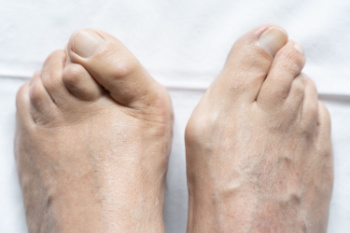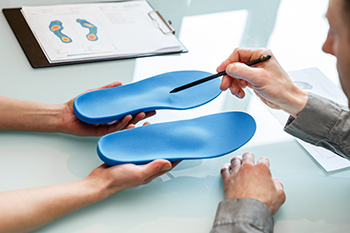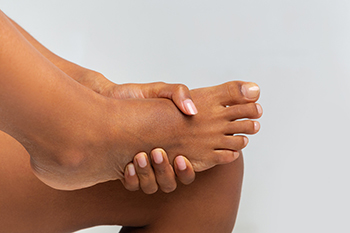Connect With Us
Blog
Items filtered by date: February 2024
Unraveling the Mystery of Bunions

Hallux valgus, commonly known as a bunion, is a medical condition that affects the joint at the base of the big toe. This condition occurs when the big toe deviates towards the smaller toes, causing a bony protrusion on the side of the foot. Bunions can result from various factors such as genetics, improper footwear, and structural foot abnormalities. Symptoms of hallux valgus include pain, swelling, and redness around the big toe joint, often aggravated by wearing tight or ill-fitting shoes. As the bunion progresses, it may lead to difficulty in finding comfortable footwear, corns or calluses, and restricted joint movement. While conservative measures like wearing proper footwear and orthotic inserts may provide relief, severe cases may require surgical intervention to correct the deformity and alleviate symptoms. Understanding hallux valgus and its symptoms is critical for early intervention and effective management, promoting foot health and overall well-being. If you have developed a bunion, it is strongly suggested that you consult a podiatrist who can offer you effective relief methods.
If you are suffering from bunion pain, contact one of our podiatrists of American Surgeons Group. Our practitioners can provide the care you need to keep you pain-free and on your feet.
What Is a Bunion?
Bunions are painful bony bumps that usually develop on the inside of the foot at the joint of the big toe. As the deformity increases over time, it may become painful to walk and wear shoes. Women are more likely to exacerbate existing bunions since they often wear tight, narrow shoes that shift their toes together. Bunion pain can be relieved by wearing wider shoes with enough room for the toes.
Causes
- Genetics – some people inherit feet that are more prone to bunion development
- Inflammatory Conditions - rheumatoid arthritis and polio may cause bunion development
Symptoms
- Redness and inflammation
- Pain and tenderness
- Callus or corns on the bump
- Restricted motion in the big toe
In order to diagnose your bunion, your podiatrist may ask about your medical history, symptoms, and general health. Your doctor might also order an x-ray to take a closer look at your feet. Nonsurgical treatment options include orthotics, padding, icing, changes in footwear, and medication. If nonsurgical treatments don’t alleviate your bunion pain, surgery may be necessary.
If you have any questions, please feel free to contact our offices located in Homewood, South Chicago Heights, and Mokena, IL . We offer the newest diagnostic and treatment technologies for all your foot care needs.
Types of Custom Orthotics

Orthotics are available in various types, each serving distinct purposes to address specific foot conditions. Functional orthotics are designed to control abnormal motion and correct foot biomechanics, providing stability and support. Rigid orthotics offer maximum control and are often used to alleviate pain from conditions like plantar fasciitis or tendonitis. Soft or accommodative orthotics provide cushioning and relieve pressure points, and are ideal for individuals with diabetic foot ulcers or arthritis. Fragile orthotics are delicate inserts tailored for sensitive feet, offering gentle support without causing discomfort. Pied sensible inserts focus on enhancing sensory feedback, aiding in balance and gait improvement. Finally, sport-specific orthotics are engineered to enhance performance and reduce injury risk during athletic activities, catering to the unique biomechanical demands of various sports. If you would like to explore custom-made orthotics for your specific foot issues, it is suggested that you schedule an appointment with a podiatrist to discuss which type of orthotic would best improve your overall comfort and mobility.
If you are having discomfort in your feet and would like to try orthotics, contact one of our podiatrists from American Surgeons Group. Our practitioners can provide the care you need to keep you pain-free and on your feet.
What Are Orthotics?
Orthotics are inserts you can place into your shoes to help with a variety of foot problems such as flat feet or foot pain. Orthotics provide relief and comfort for minor foot and heel pain but can’t correct serious biomechanical problems in your feet.
Over-the-Counter Inserts
Orthotics come in a wide variety of over-the-counter inserts that are used to treat foot pain, heel pain, and minor problems. For example, arch supports can be inserted into your shoes to help correct overarched or flat feet, while gel insoles are often used because they provide comfort and relief from foot and heel pain by alleviating pressure.
Prescription Orthotics
If over-the-counter inserts don’t work for you or if you have a more severe foot concern, it is possible to have your podiatrist prescribe custom orthotics. These high-quality inserts are designed to treat problems such as abnormal motion, plantar fasciitis, and severe forms of heel pain. They can even be used to help patients suffering from diabetes by treating foot ulcers and painful calluses and are usually molded to your feet individually, which allows them to provide full support and comfort.
If you are experiencing minor to severe foot or heel pain, it’s recommended to speak with your podiatrist about the possibilities of using orthotics. A podiatrist can determine which type of orthotic is right for you and allow you to take the first steps towards being pain-free.
If you have any questions please contact our offices located in Homewood, South Chicago Heights, and Mokena, IL . We offer the newest diagnostic and treatment technologies for all your foot and ankle needs.
Gout Pain Can Be Managed
Foot Concerns in Children

Foot conditions in children can arise for a variety of reasons, often requiring attention and intervention to ensure optimal foot health and development. Flat feet, a condition where the arches of the feet are lower than usual, are a common concern among children. While flat feet often resolve on their own as the child grows, persistent issues may require orthotic intervention to provide support and promote proper alignment. Another prevalent issue is ingrown toenails, which occur when the edge of the toenail grows into the surrounding skin, causing pain and discomfort. Wearing tight or improperly fitted footwear is a common culprit behind ingrown toenails. Additionally, conditions such as plantar warts, athlete's foot, and foot deformities such as bunions or hammertoes may affect children's feet. Regular foot inspections, proper footwear, and seeking prompt medical attention from a podiatrist for any concerning symptoms are essential practices to address foot problems in children. If you are concerned about your children’s feet, it is suggested that you consult a podiatrist who can ease your mind while pinpointing and treating the specific condition.
The health of a child’s feet is vital to their overall well-being. If you have any questions regarding foot health, contact one of our podiatrists of American Surgeons Group. Our practitioners can provide the care you need to keep you pain-free and on your feet.
Tips for Keeping Children's Feet Healthy
- Make sure their shoes fit properly
- Look for any signs of in-toeing or out-toeing
- Check to see if they have Clubfoot (condition that affects your child’s foot and ankle, twisting the heel and toes inward) which is one of the most common nonmajor birth defects.
- Lightly cover your baby’s feet (Tight covers may keep your baby from moving their feet freely, and could prevent normal development)
- Allow your toddler to go shoeless (Shoes can be restricting for a young child’s foot)
- Cut toenails straight across to avoid ingrown toenails
- Keep your child’s foot clean and dry
- Cover cuts and scrapes. Wash any scratches with soap and water and cover them with a bandage until they’ve healed.
If you have any questions, please feel free to contact our offices located in Homewood, South Chicago Heights, and Mokena, IL . We offer the newest diagnostic and treatment technologies for all your foot care needs.
A Closer Look at How CRPS Can Affect the Feet
 Complex regional pain syndrome, or CRPS, a perplexing and debilitating condition, manifests as chronic pain, swelling, and changes in skin color and temperature, often affecting the extremities. When CRPS strikes the feet, it introduces a unique set of challenges for individuals grappling with this complex disorder. The condition arises typically after an injury or trauma, triggering an abnormal response in the nervous system. In the feet, CRPS can lead to severe, constant pain, sensitivity to touch, and difficulty bearing weight. The affected foot may change skin texture, temperature, and color, presenting a mosaic of symptoms that defy conventional explanations. Understanding how CRPS impacts the feet is essential for accurate diagnosis and tailored treatment plans. If you have foot pain that encompasses the above symptoms, it is strongly suggested that you seek the counsel of a podiatrist who can accurately diagnose and treat CRPS.
Complex regional pain syndrome, or CRPS, a perplexing and debilitating condition, manifests as chronic pain, swelling, and changes in skin color and temperature, often affecting the extremities. When CRPS strikes the feet, it introduces a unique set of challenges for individuals grappling with this complex disorder. The condition arises typically after an injury or trauma, triggering an abnormal response in the nervous system. In the feet, CRPS can lead to severe, constant pain, sensitivity to touch, and difficulty bearing weight. The affected foot may change skin texture, temperature, and color, presenting a mosaic of symptoms that defy conventional explanations. Understanding how CRPS impacts the feet is essential for accurate diagnosis and tailored treatment plans. If you have foot pain that encompasses the above symptoms, it is strongly suggested that you seek the counsel of a podiatrist who can accurately diagnose and treat CRPS.
Foot Pain
Foot pain can be extremely painful and debilitating. If you have a foot pain, consult with one of our podiatrists from American Surgeons Group. Our practitioners will assess your condition and provide you with quality foot and ankle treatment.
Causes
Foot pain is a very broad condition that could be caused by one or more ailments. The most common include:
- Bunions
- Hammertoes
- Plantar Fasciitis
- Bone Spurs
- Corns
- Tarsal Tunnel Syndrome
- Ingrown Toenails
- Arthritis (such as Gout, Rheumatoid, and Osteoarthritis)
- Flat Feet
- Injury (from stress fractures, broken toe, foot, ankle, Achilles tendon ruptures, and sprains)
- And more
Diagnosis
To figure out the cause of foot pain, podiatrists utilize several different methods. This can range from simple visual inspections and sensation tests to X-rays and MRI scans. Prior medical history, family medical history, and any recent physical traumatic events will all be taken into consideration for a proper diagnosis.
Treatment
Treatment depends upon the cause of the foot pain. Whether it is resting, staying off the foot, or having surgery; podiatrists have a number of treatment options available for foot pain.
If you have any questions, please feel free to contact our offices located in Homewood, South Chicago Heights, and Mokena, IL . We offer the newest diagnostic and treatment technologies for all your foot care needs.

